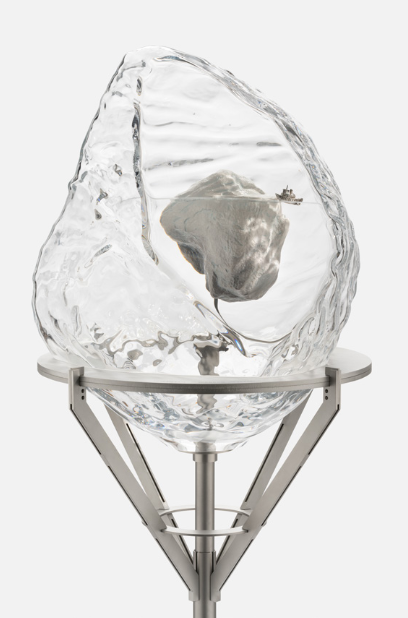
HOW BIG IS AN ICEBERG?
Have you ever heard the expression “it is just the tip of the iceberg“? It means that we only see the top of the iceberg; the rest is below the surface.
Actually we only see 10%.

Write a short story where the point is: “it was just the tip of the iceberg“.
Icebergs from Sermeq Kujalleq can become 900 metres tall.
Try comparing that with other tall objects. You could use the Internet.
Estimate how high this iceberg is (pp. 28-29). Assume that the person in the picture is 170 cm tall.
When the iceberg floats through the Icefjord it melts from below. It changes form and loses the balance.
What do you see in the video on this page? It is in the black square.
What is the difference in density of frozen and liquid water?
On page 31 are three models showing an iceberg breaking from the glacier. Draw more pictures where you demonstrate the iceberg flipping over.
The largest Greenlandic icebergs take three to four years to melt. Before they melt completely they drift far into the ocean.

How many degrees of longitude and latitude is the globe divided into? Inside what degrees of longitude and latitude are the icebergs shown on the map?
What ocean currents are indicated on the map?
What ocean currents did transport the iceberg that Titanic collided with? How long time did the journey take from Ilulissat till the collision with the Titanic? Look at the map (page 32).
Have you ever heard the expression “it is just the tip of the iceberg“? It means that we only see the top of the iceberg; the rest is below the surface.
Actually we only see 10%.

Write a short story where the point is: “it was just the tip of the iceberg“.
Icebergs from Sermeq Kujalleq can become 900 metres tall.
Try comparing that with other tall objects. You could use the Internet.
Estimate how high this iceberg is (pp. 28-29). Assume that the person in the picture is 170 cm tall.
When the iceberg floats through the Icefjord it melts from below. It changes form and loses the balance.
What do you see in the video on this page? It is in the black square.
What is the difference in density of frozen and liquid water?
On page 31 are three models showing an iceberg breaking from the glacier. Draw more pictures where you demonstrate the iceberg flipping over.
The largest Greenlandic icebergs take three to four years to melt. Before they melt completely they drift far into the ocean.

How many degrees of longitude and latitude is the globe divided into? Inside what degrees of longitude and latitude are the icebergs shown on the map?
What ocean currents are indicated on the map?
What ocean currents did transport the iceberg that Titanic collided with? How long time did the journey take from Ilulissat till the collision with the Titanic? Look at the map (page 32).




